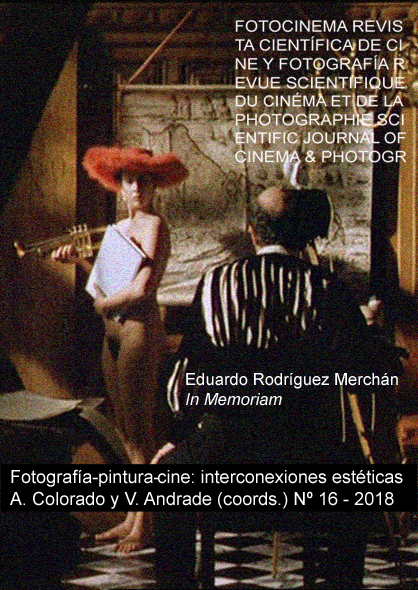“The Countess is Dead”. Metamorphosed pictorial inheritances in l’Apollonide (Bertrand Bonello, 2011)
DOI:
https://doi.org/10.24310/Fotocinema.2018.v0i16.4099Keywords:
Cinema and painting, L’Apollonide, Visual Culture, Intertextuality, Art and CinemaAbstract
We intend to trace the pictorial heritage that emerges in the staging of L'Apollonide, Souvenirs of the maison closee (Bertrand Bonello, 2011), whose meaning transcends the mere ambience of the time. Post-impressionist toilettes, symbolist orientalisms and outings to impressionistic landscapes are part of the references of which the film is nourished and, at the same time, metamorphosizes in order to write a story detained in the eternal ending of the nineteenth century, whose laconic tedium and militant artificiality are no obstacle to the ruthless irruption of barbarism. Starting from the identification of intertextualities and the textual analysis of filmic materiality, we propose that L'Apollonide apprehends the aesthetic and the decadent feeling of French art in the twilight of the century to build a story that humanizes —through a contemporary look— the day-to-day life of the prostitutes who work in an elitist brothel about to shutting. The configuration of the mise-en-scène demands the identifiction of certain pictorial referents key in order to rethink, redraw and propose a reverse to the myth of the pictorial femme fatale.
Downloads
Metrics
Publication Facts
Reviewer profiles N/A
Author statements
Indexed in
-
—
- Academic society
- N/A
- Publisher
- Universidad de Málaga
References
Baran?ano, K. de. (2016). Criterios sobre la historia del arte. Madrid: Kailas.
Bazin, A. (1990). ¿Que? es el cine? (2a ed.). Madrid: Rialp.
Benjamin, W. (2004). Sobre la fotografía. Valencia: Pre-Textos.
Bornay, E. (1990). Las hijas de Lilith. Madrid: Ca?tedra.
Bronfen, E. (1992). Over her dead body: death, femininity and the aesthetic. Manchester : Manchester University Press.
Clayson, H. (2003). Painted Love. Prostitution in French Art of the Impressionist Era. The Getty Research Institute.
Dijkstra, B. (1994). Idolos de perversidad : La imagen de la mujer en la cultura de fin de siglo. Barcelona: Círculo de Lectores.
Eco, U., De Michel, G., & Pons Irazazábal, M. (2004). Historia de la belleza. Barcelona: Lumen.
Fuchs, E. (1996). Historia ilustrada de la moral sexual. Madrid: Alianza.
Gaudreault, A. (1988). Du litte?raire au filmique : syste?me du re?cit. Paris: Presses de l’Universite? Laval.
Gómez Tarín, F. J., & Marzal Felici, J. J. (2015). Diccionario de conceptos y términos audiovisuales : herramientas para el análisis fílmico. Madrid: Cátedra.
Mínguez Cornelles, V., & Rodríguez Moya, I. (2014). Visiones de pasión y perversidad. Fernando de Villaverde Ediciones.
Losilla, C. (2012). A la espera del fin. Caimán cuadernos de cine.
Ortega Ventureira, P. (2015). La mujer crucificada en el fin de siglo. Madrid: Universidad Autónoma de Madrid.
Pedraza, P. (1991). La bella, enigma y pesadilla: esfinge, medusa, pantera... Barcelona: Tusquets Editores.
Pedraza, P. (1998). Ma?quinas de amar: secretos del cuerpo artificial. Madrid: Valdemar.
Pedraza, P. (2009). El regreso de la mujer muerta. Dossiers feministes, 13, 45-50.
Rodríguez Serrano, A. (2013). Más allá del pop: Primeros apuntes sobre la música en Bertrand Bonello. El rayo verde, 31-37.
Segade, M. (2008). Narciso fin de siglo. Barcelona: Editorial Melusina.
Sorolla Romero, T., & García Catalán, S. (2014). Morfologías de nuestros áridos días felices. L’Atalante. Revista de estudios cinematográficos, 46-52.
Villena, L. A. de (2001). Diccionario esencial del fin de siglo. Madrid : Valdemar.
Downloads
Published
How to Cite
Issue
Section
License
All contents published in Fotocinema Revista científica de cine y fotografía are protected under the Creative Commons Attribution-NonCommercial-ShareAlike 4.0 International (CC BY-NC-SA 4.0) license. All about this license is available in the following link: <http://creativecommons.org/licenses/by-nc-sa/4.0>
Users can copy, use, redistribute, share and exhibit publicly as long as:
- The original source and authorship of the material are cited (Journal, Publisher and URL of the work).
- It is not used for comercial purposes.
- The existence of the license and its especifications are mentioned.
There are two sets of authors’ rights: moral and property rights. Moral rights are perpetual prerogatives, unrenounceable, not-transferable, unalienable, imprescriptible and inembargable. According to authors’ rights legislation, Fotocinema. Revista científica de cine y fotografía recognizes and respects authors moral rights, as well as the ownership of property rights, which will be transferred to University of Malaga in open access. The property rights are referred to the benefits that are gained by the use or the dissemination of works. Fotocinema. Revista científica de cine y fotografía is published in an open access form and it is exclusively licenced by any means for doing or authorising distribution, dissemination, reproduction, , adaptation, translation or arrangement of works.
Authors are responsable for obtaining the necessary permission to use copyrighted images.














13.png)



